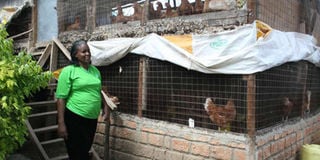Guiding checklist for construction of best chicken house

A farmer outside her poultry house in Kisumu. An ideal poultry house should provide the birds with a comfortable environment and protect them from the extremities of the prevailing weather. FILE PHOTO | NMG
What you need to know:
- The roof of the house should have a reflecting surface and pitched with overlaps to ensure that the house is comfortable and well ventilated.
- The feed store should also be separate from the house to reduce risk of attracting rodents.
- On poultry farms, an all-in all-out system is the best management practice as it prevents the buildup of disease causing organisms and disease outbreaks.
- For our local environment, where houses are open-sided, ventilation is managed by opening the curtains from top when it gets warm.
Poultry house set up and ventilation
Commercial chicken farming requires a high-level of expertise, understanding and commitment to be successful.
Whilst it’s important to emphasize the need for excellent flock stockmanship at all times, something that comes with experience and aptitude, adopting the correct housing techniques and equipment will set a firm foundation for success.
The following is a guiding checklist for poultry house construction;
A poultry house should provide the birds with a comfortable environment and protect them from the extremities of the prevailing weather (rain, wind and sunshine).
It should have adequate space for the flock to be kept in the house. The ideal stocking density is:
- Layers: Two square foot per bird (2sqfoot/bird).
- Broilers: One square foot per bird (1sqfoot/bird).
It should be open-sided to allow natural ventilation with an east-west orientation to minimise the amount of sunlight entering the house directly.
It should be rectangular in shape and have a wall not higher than three feet on the longer side.
This wall can be made from stones, iron sheets, timber, silver boards or bricks
The rest of the side of the wall should have a chicken wire mesh. The wire mesh on the sides of the house should be of a small gauge to prevent entry of wild birds, dogs and rodents.
The roof of the house should have a reflecting surface and pitched with overlaps to ensure that the house is comfortable and well ventilated.
Cement floors are the best finishing as they are easier to clean.
There should be a foot-bath at the entrance of the house for those entering the to disinfect their foot wear.
To reduce the risk of rodents gaining entrance into the flock house, clear all the vegetation in a radius of 3-5 metres around the pen.
The feed store should also be separate from the house to reduce risk of attracting rodents.
It should be constructed in isolated areas to minimise the risk of contamination.
The house should be fenced to exclude stray animals and visitors.
The doors should always be locked.
On poultry farms, an all-in all-out system is the best management practice as it prevents the buildup of disease causing organisms and disease outbreaks.
In case where farmers want to keep flocks of different ages, then each flock must be housed in its own.
Ventilation
Ventilation is the circulation of fresh air through the flock house and exhaustion of stale air out of the flock units and its achieved by air passing from one side of the house and exhausting through the opposite side.
Ventilation of poultry houses serves several functions including:
Removing excess heat and moisture.
Providing oxygen while removing harmful gases.
Reducing dust hence improving the air quality.
For our local environment, where houses are open-sided, ventilation is managed by opening the curtains from top when it gets warm.
This lets air from outside into the house. When it gets cold the curtains are raised up and closed to restrict the flow of air.
You must always allow optimal ventilation to avoid chicks getting suffocated.
The article was compiled by poultry experts from Kenchic.




